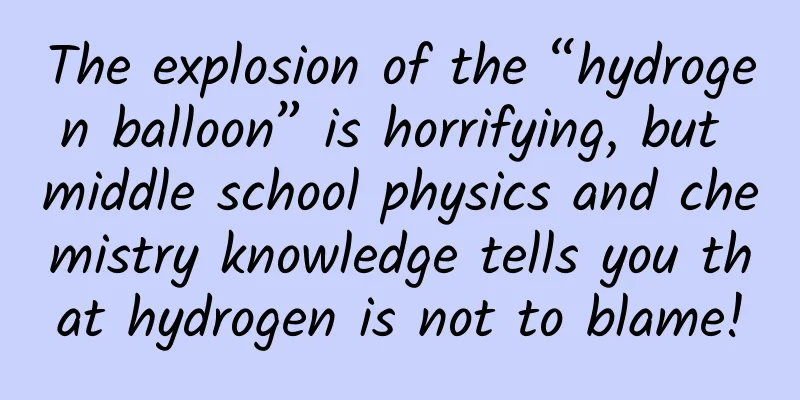The explosion of the “hydrogen balloon” is horrifying, but middle school physics and chemistry knowledge tells you that hydrogen is not to blame!

|
On New Year's Eve, December 31, 2024, a video of a hydrogen balloon suddenly exploding went viral, which was heartbreaking. According to official reports, a hydrogen balloon brought by the public exploded at Wanda Plaza in Yangshan New District, Xinyang City, Henan Province, and some people suffered minor burns at the scene. The official report also pointed out: "Hydrogen is a flammable and explosive gas. Hydrogen balloons are prone to explosion when exposed to open flames, static electricity, etc. There are great risks in using and selling hydrogen balloons in crowded places." In fact, there are often warnings prohibiting the release of hydrogen balloons. Was the phenomenon at the scene really caused by "hydrogen balloons"? Why did it explode? Written by Li Cunpu (National Key Laboratory of Special Chemical Power Sources, Professor of the School of Chemistry and Chemical Engineering, Chongqing University) On New Year's Eve in 2024, a video of people scrambling to grab a "hydrogen balloon" and the balloon suddenly burst into flames was circulated in many people's friend circles and WeChat groups. In this video, which is only 10 seconds long, several people wearing thick winter clothes crowded around two clusters of colorful balloons full of festive atmosphere. In the 9th second of the video, a yellow flame gushed out and ignited the two clusters of balloons in less than 1 second, and the picture stopped abruptly. On this quiet and peaceful New Year's Eve, an explosion occurred among the crowd, causing netizens who saw the video to worry about the safety of the people at the scene. Figure 1: In the first second of the video screenshot, people are scrambling for balloons. In the ninth second of the video screenshot, a yellow flame is generated and quickly ignites two clusters of balloons within 1 second, resulting in an explosion at the scene. It was not until the next day, New Year's Day, that the news media reported that "On December 31, hydrogen balloons brought by the public exploded at Wanda Plaza in Yangshan New District, Xinyang City, and some people suffered minor burns at the scene." An explosion occurred during the lively and peaceful New Year's Eve. The yellow flames engulfed the crowd in just one second, which is still frightening. What happened at the scene, why did the above accident happen, and how to prevent this seemingly unpreventable "hydrogen balloon" accident? 1 "Hydrogen balloons" are not filled with real "hydrogen" What many people don’t know is that the “hydrogen balloons” we buy on the market are often not filled with hydrogen. In fact, when we want a balloon to float, we only need to fill it with a gas whose density is less than that of air. Since the molar volume of ideal gases is the same at the same temperature and pressure [for example, we learned in middle school that under standard conditions (0°C, 101.325kPa), 1 mole of any ideal gas occupies a volume of about 22.4 liters], according to the ideal gas state equation pV=nRT, it can be easily concluded that pM=ρRT, that is, the gas density ρ under ideal conditions is proportional to the molar mass M of the gas. The molecular weight of air M≈29, so filling a balloon with a gas with a molecular weight less than 29 can theoretically allow the balloon to float spontaneously in the air. Of course, considering that the outer material of the balloon also has weight and its density is much greater than that of the gas, the molecular weight of the filling gas is preferably much smaller than 29 g/mol. As the lightest gas, hydrogen with a molecular weight of 2 is obviously an ideal filling material from the perspective of floating upward. In addition, some businesses also fill balloons with inert gas helium (molecular weight 4). In fact, both hydrogen and helium have been used in large-scale flying equipment such as airships, but hydrogen is flammable and explosive. The Hindenburg airship crash in 1937 was caused by the explosion of hydrogen filled in the airship (Figure 2a). The accident caused 36 deaths and completely defeated the airship in the competition with airplanes [1]. Of course, since airships can realize the air transportation of personnel/equipment at low cost and large load, airships are still being developed and applied. The gas they are filled with is mostly helium. The Kirov airship in the classic RTS game "Red Alert 2" can be clearly seen from the game voice that the gas filled inside is helium, and therefore only impact damage will be caused when it is shot down instead of explosion damage. Figure 2 (a) The Hindenburg airship crash, which killed 36 people; (b) The Kirov airship in the game "Red Alert 2", which will announce "Helium mix optimal" when selected, indicating that the gas it is filled with is helium. Because the idea of filling balloons with hydrogen is deeply rooted in people's minds, in the Chinese context, people often call floating balloons "hydrogen balloons"; in the English context, helium balloon is more widely used. But in fact, the hydrogen balloons we usually buy from vendors are filled with neither hydrogen nor helium. The reason is very simple. Helium is safe, but the production cost is high (this is another complicated physics story), and real helium balloons are relatively expensive; and although hydrogen is relatively easy to prepare, it requires special equipment and licenses for storage and transportation, and it is obviously not a gas that can be easily obtained by mobile vendors. Natural gas, which is easy to obtain, low-cost, and has a molecular weight less than 29 as much as possible, has become the mainstream choice for filling "hydrogen balloons". The main component of natural gas is methane (CH4), which has a molecular weight of only 16 and is easy to obtain. It can even be directly connected from the natural gas pipeline at home (but it is illegal to connect natural gas privately!) Therefore, the so-called "hydrogen balloons" we bought are actually more appropriately called "natural gas-balls". Natural gas is easy to burn and its flame is yellow, while hydrogen often burns with a blue flame. Judging from the yellow flame shown in the balloon explosion accident in Figure 1, the burning gas should be natural gas - or mainly methane. However, there is still a question here: if two clusters of balloons were ignited instantly, would the outer skin of the balloons also catch fire when exposed to fire? 2 The outer shell of the "hydrogen balloon" The outer skin of a balloon is indeed flammable and explosive. There are two main types of outer skin materials for common balloons: one is the latex material shown in Figure 3a, which is small when not inflated and gradually expands during inflation; the other is the aluminum film balloon shown in Figure 3b, which does not deform with changes in air pressure, and the gas fills the reserved space inside. Figure 3 (a) Latex balloon; (b) Aluminum film balloon There are many common natural latex products in our daily life, such as gloves, pillows, etc. This material has very good elasticity and tensile properties. As a type of polymer material, it is very easy to burn. The gas tightness of natural latex balloons is not good enough, so later people developed aluminum film balloons, which have better air tightness and can allow balloons to float in the air for a longer time. The name of the aluminum film balloon is easy to be misunderstood, as people think that it is made of aluminum foil, so it should not be easy to burn. In fact, the aluminum film material is a composite material, the inner layer of which is biaxially stretched polyethylene terephthalate (BoPET), and the outer layer is a thin layer of deposited metal aluminum. Because its outer layer has a shiny metallic luster, it is considered to be mainly composed of aluminum. BoPET is also often used as the outer layer of books and photos; BoPET has a more famous relative, PET (polyethylene terephthalate), which can be found in mineral water bottles and quick-drying clothes. Therefore, as a polymer material, the outer skin of the aluminum film balloon is also very easy to burn. So - why did the explosion happen? 3 Behind the Explosion: Electricity and Fire Are Everywhere Although the cause of the accident has not yet been investigated, we might as well speculate on the next possible cause. If you pull the page back to Figure 1 and carefully observe the clothes of the onlookers at the scene, you will notice that the author specifically described "several people wearing thick winter clothes" before. In order to achieve a better windproof effect, the outer fabrics of winter clothes are mostly chemical fibers, which are more likely to generate static electricity through friction than natural materials. In the scene in Figure 1, the friction between clothes and clothes, and clothes and balloons is likely to generate static electricity, and static electricity will instantly ignite when it encounters leaked gas (the balloons used in Figure 1 are latex balloons, which are more likely to leak air); the flames encounter the latex outer skin of other balloons and burn them, causing the internal flammable natural gas to leak, and eventually produce an explosion, and everything is completed within 1 second. Therefore, "hydrogen balloons" - whether filled with hydrogen or not - are often not allowed to be brought into crowded places and enclosed spaces. I have encountered other passengers carrying balloons and being intercepted when taking the subway more than once - the reason is simple. Once a balloon accidentally floats into a subway tunnel, even if the balloon may burst, the flammable gas will be trapped in the tunnel. The subway draws electricity by contacting the power grid. When electricity encounters flammable gas, it is very easy to cause catastrophic accidents. 4 Conclusion Colorful balloons are a good way to add to the festive atmosphere, but the more festive it is, the more attention should be paid to safety precautions. After all, safety is a blessing. I wish all readers happiness and good health in 2025. Special Tips 1. Go to the "Featured Column" at the bottom of the menu of the "Fanpu" WeChat public account to read a series of popular science articles on different topics. 2. Fanpu provides a function to search articles by month. Follow the official account and reply with the four-digit year + month, such as "1903", to get the article index for March 2019, and so on. Copyright statement: Personal forwarding is welcome. Any form of media or organization is not allowed to reprint or excerpt without authorization. For reprint authorization, please contact the backstage of the "Fanpu" WeChat public account. |
>>: 12345 drawn? Deciphering the "secret code" of ancient Egypt
Recommend
The logic behind traffic: How to achieve community fission growth?
This article uses real data to deeply reveal the ...
Service Mesh Istio Basics and Practice
Introduction to the basics and practical resource...
Still not spacious enough? The new Ghost will be longer
Speaking of the Rolls-Royce Ghost, it is a super-...
Do “sleep-aiding foods” really help you sleep?
This is the 4373rd article of Da Yi Xiao Hu Sleep...
A new perspective on the origin of the universe! The universe unfolds: time disappears in the Big Bang?
Understanding the origin of the universe has alwa...
The “universal” methodology for bidding advertising!
The editor has personally operated and placed adv...
Why is plague so difficult to eradicate? The plague that killed hundreds of millions of people was not spread by rats
It is a great feat that humans have been able to ...
Original, pure, and magnificent! Explore China's least-known "no man's land"
Human civilization spreads across all continents ...
How to transform your advertising from dissemination to “broadcasting”?
Recently, I took out Teacher Hua Shan’s "Sup...
SEO is not a cheating method
In the past two years, SEO has received more and ...
How to make sign-in a powerful tool to increase user activity!
This article will explain which apps are suitable...
How to achieve high conversion rate in WeChat public account advertising
In the market segments of various advertising cha...
Why is the entry-level capacity of iPhone only 16GB?
If Apple follows its usual path, its next generat...
If you don't wash your hair for a day, it will become oily! Is there any hope for people with oily hair? You may be washing your hair the wrong way!
Sitting at the workstation, my mind is empty Othe...
AppCan receives RMB 100 million in Series B funding and announces open source mobile engine
Recently, AppCan, the advocate and leader of hybr...









